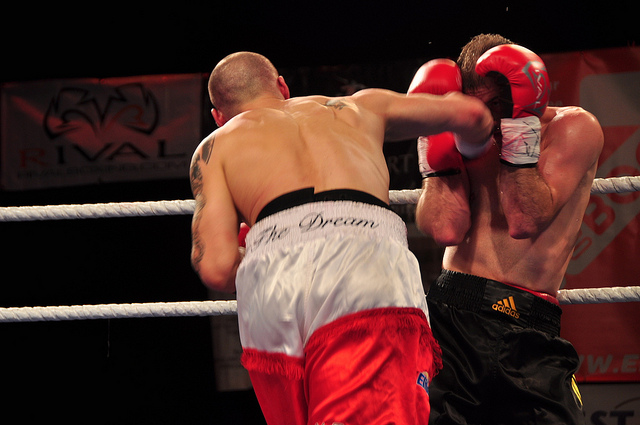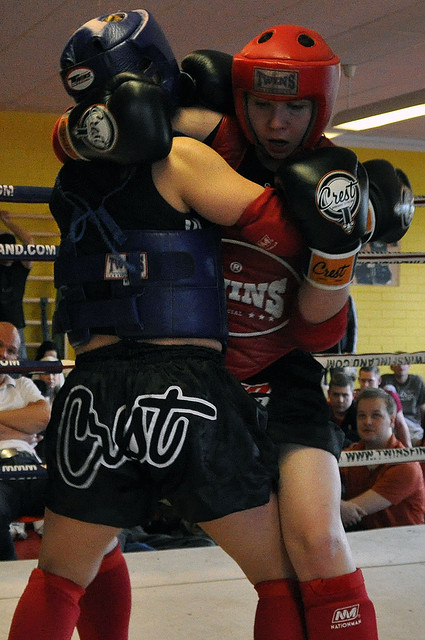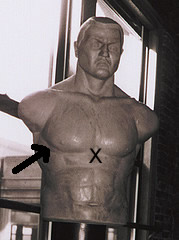The pendulum step is an essential footwork technique for boxers.
It is useful for resting while maintaining movement and the ability to react quickly when outside of striking distance, as a propulsion and timing mechanism for more advanced attacks, and as a conditioning tool during training sessions. Because it uses more energy than standing still, you should be careful about when and how you use it.
When you punch or are in striking range of your opponent, your feet are planted to generate power and movement through your legs. As they are firmly anchored they are doing a significant amount of work and muscles are tensed and contracted. The pendulum step is useful when you move out of striking distance to give your legs a bit of a break before moving back in for another attack. As you shift weight from one to the other you give them small breaks at the expense of increasing your cardio system's energy expenditure.
When timed correctly, the pendulum step is very effective at delivering a powerful jab that will completely catch your opponent off guard. As a component of the attack it utilizes momentum from both yourself and your opponent to magnify the striking power of the jab while keeping you out of range of a retaliatory blow. It also allows you to dart in and out of range much quicker to give you additional offensive and defensive options.
As a conditioning tool - it takes more energy to keep moving up on your toes thus it burns more calories and the work against gravity places a greater workload on your calves much like skipping.
Sound intriguing?
The pendulum step is an essential footwork technique for boxers.
It is useful for resting while maintaining movement and the ability to react quickly when outside of striking distance, as a propulsion and timing mechanism for more advanced attacks, and as a conditioning tool during training sessions. Because it uses more energy than standing still, you should be careful about when and how you use it.
When you punch or are in striking range of your opponent, your feet are planted to generate power and movement through your legs. As they are firmly anchored they are doing a significant amount of work and muscles are tensed and contracted. The pendulum step is useful when you move out of striking distance to give your legs a bit of a break before moving back in for another attack. As you shift weight from one to the other you give them small breaks at the expense of increasing your cardio system's energy expenditure.
When timed correctly, the pendulum step is very effective at delivering a powerful jab that will completely catch your opponent off guard. As a component of the attack it utilizes momentum from both yourself and your opponent to magnify the striking power of the jab while keeping you out of range of a retaliatory blow. It also allows you to dart in and out of range much quicker to give you additional offensive and defensive options.
As a conditioning tool - it takes more energy to keep moving up on your toes thus it burns more calories and the work against gravity places a greater workload on your calves much like skipping.
Sound intriguing?
What is the Pendulum Step?
What is the Pendulum Step?
The movement is relatively straight forward as both a means of conditioning and rest - simple back and forth motion - hopping from front to back to front up on your toes with your hands up or down depending on how close you are to your opponent (resting) or the aim of the conditioning session.
The movement becomes much more interesting when you use it in your offensive and defensive game.
If you've watched Muhammed Ali box you'll have a pretty good idea how this works. You bounce back and forth from toe to toe almost like you are skipping. The hops are small and controlled basically putting your head in range and then pulling it out of range just as quick. Not a lot different than the typical boxing stance except there is constant movement in a pendulum motion - forward and back, forward and back.
As you are actually lifting your weight off the mat, this is also a dangerous move. Timed right, your opponent can knock you flat out simply because you have no contact with the floor. At the same time, the momentum you build up gives you the ability to change directions in a split second and transition into various combinations at will.
I'll describe one way of how this can work for you as an attack.
The movement is relatively straight forward as both a means of conditioning and rest - simple back and forth motion - hopping from front to back to front up on your toes with your hands up or down depending on how close you are to your opponent (resting) or the aim of the conditioning session.
The movement becomes much more interesting when you use it in your offensive and defensive game.
If you've watched Muhammed Ali box you'll have a pretty good idea how this works. You bounce back and forth from toe to toe almost like you are skipping. The hops are small and controlled basically putting your head in range and then pulling it out of range just as quick. Not a lot different than the typical boxing stance except there is constant movement in a pendulum motion - forward and back, forward and back.
As you are actually lifting your weight off the mat, this is also a dangerous move. Timed right, your opponent can knock you flat out simply because you have no contact with the floor. At the same time, the momentum you build up gives you the ability to change directions in a split second and transition into various combinations at will.
I'll describe one way of how this can work for you as an attack.
Using the Pendulum Step to Attack
Using the Pendulum Step to Attack
In this technique you use the pendulum step to tempt your opponent to commit to an attack. You put your head into striking distance to lure your opponent into throwing a jab which you will promptly return with something a lot more powerful.
As you hop in a controlled manner from front foot to back foot - forward to back - you put your head in and out of range. Doing this at some point will entice your opponent to attack and throw a jab. When you see it coming you have to immediately jam your front foot into the floor and push back to get out of range of the jab - backwards in a straight line. You're not done though -- as soon as you've cleared the range of the jab, slam your back foot down propelling yourself forward with a counter jab of your own. Timed right, you will follow your opponent's jab back striking your opponent with the force of your jab, your forward momentum, and momentum of your opponent.
The result will completely stun your opponent and regain you the initiative. It's shock action at its best.
It's also dangerous. Jabs rarely come in singles so if you propel yourself at your opponent at the wrong time you can run into a second jab or worse - a straight right. Thus, it's important to use this technique when you know your opponent is more of a one-jab pony.
In this technique you use the pendulum step to tempt your opponent to commit to an attack. You put your head into striking distance to lure your opponent into throwing a jab which you will promptly return with something a lot more powerful.
As you hop in a controlled manner from front foot to back foot - forward to back - you put your head in and out of range. Doing this at some point will entice your opponent to attack and throw a jab. When you see it coming you have to immediately jam your front foot into the floor and push back to get out of range of the jab - backwards in a straight line. You're not done though -- as soon as you've cleared the range of the jab, slam your back foot down propelling yourself forward with a counter jab of your own. Timed right, you will follow your opponent's jab back striking your opponent with the force of your jab, your forward momentum, and momentum of your opponent.
The result will completely stun your opponent and regain you the initiative. It's shock action at its best.
It's also dangerous. Jabs rarely come in singles so if you propel yourself at your opponent at the wrong time you can run into a second jab or worse - a straight right. Thus, it's important to use this technique when you know your opponent is more of a one-jab pony.
How to Practice the Pendulum Step
How to Practice the Pendulum Step
1. With a partner: Start slow and get the timing right. Get into the pendulum step hopping forward and back in front of your partner. Have your partner throw continuous jabs and get the feel for evading them backwards in time with your hops and then moving forward as your partner draws his jab back. Once you have that, go for the attack. Practice as before, but this time throw a jab on the return trying to beat your opponent's jab back to the guard.
2. Without a partner: If all you've got is a heavy bag, you can still practice this. Give the bag a push and then get moving in the pendulum motion in time with the bag. Picture a jab coming at you as the bag moves toward you and take a slightly bigger hop back (that simulates evading the jab). When you land, propel forward with a jab of your own catching the bag as it is moving away from you (simulates the withdraw of the jab). The quicker you can catch the bag with your jab as it is moving back the better you are getting.
1. With a partner: Start slow and get the timing right. Get into the pendulum step hopping forward and back in front of your partner. Have your partner throw continuous jabs and get the feel for evading them backwards in time with your hops and then moving forward as your partner draws his jab back. Once you have that, go for the attack. Practice as before, but this time throw a jab on the return trying to beat your opponent's jab back to the guard.
2. Without a partner: If all you've got is a heavy bag, you can still practice this. Give the bag a push and then get moving in the pendulum motion in time with the bag. Picture a jab coming at you as the bag moves toward you and take a slightly bigger hop back (that simulates evading the jab). When you land, propel forward with a jab of your own catching the bag as it is moving away from you (simulates the withdraw of the jab). The quicker you can catch the bag with your jab as it is moving back the better you are getting.
Some Tips
Some Tips
This step is all about timing and conditioning yourself to decrease your reaction time. This will help develop your reflexes while increasing footwork agility. When the basic pendulum step starts to become second nature, you can increase the level of difficulty by bringing angles into the equation. When you do the evade, hop back and to a side. This will give you an even clearer shot at your opponent on the counter attack. You can also try throwing other kinds of punches. The jab is most effective because you can shoot it out extremely quickly and you are well aligned to do so, but a quick hook or uppercut could also be effective (or a hybrid of both).
This step is all about timing and conditioning yourself to decrease your reaction time. This will help develop your reflexes while increasing footwork agility. When the basic pendulum step starts to become second nature, you can increase the level of difficulty by bringing angles into the equation. When you do the evade, hop back and to a side. This will give you an even clearer shot at your opponent on the counter attack. You can also try throwing other kinds of punches. The jab is most effective because you can shoot it out extremely quickly and you are well aligned to do so, but a quick hook or uppercut could also be effective (or a hybrid of both).
What to Avoid
What to Avoid
Consider the amount of energy you are willing to use to maintain the pendulum motion. Ensure you are well-conditioned if you plan on using it.
The constant forward and back is rhythmic and easily timed. It creates a predictable pattern and telegraphs where your head is going to be as you come forward. Once in the air you can't change direction.
When using the attack described - eventually, your opponent will figure out what you are doing and use it against you by faking their jab and then catch you hard as you come in. The skill level of your opponent will dictate how often and how long you can use the technique before running into problems. It obviously works better with someone who is not expecting it.
Consider the amount of energy you are willing to use to maintain the pendulum motion. Ensure you are well-conditioned if you plan on using it.
The constant forward and back is rhythmic and easily timed. It creates a predictable pattern and telegraphs where your head is going to be as you come forward. Once in the air you can't change direction.
When using the attack described - eventually, your opponent will figure out what you are doing and use it against you by faking their jab and then catch you hard as you come in. The skill level of your opponent will dictate how often and how long you can use the technique before running into problems. It obviously works better with someone who is not expecting it.





